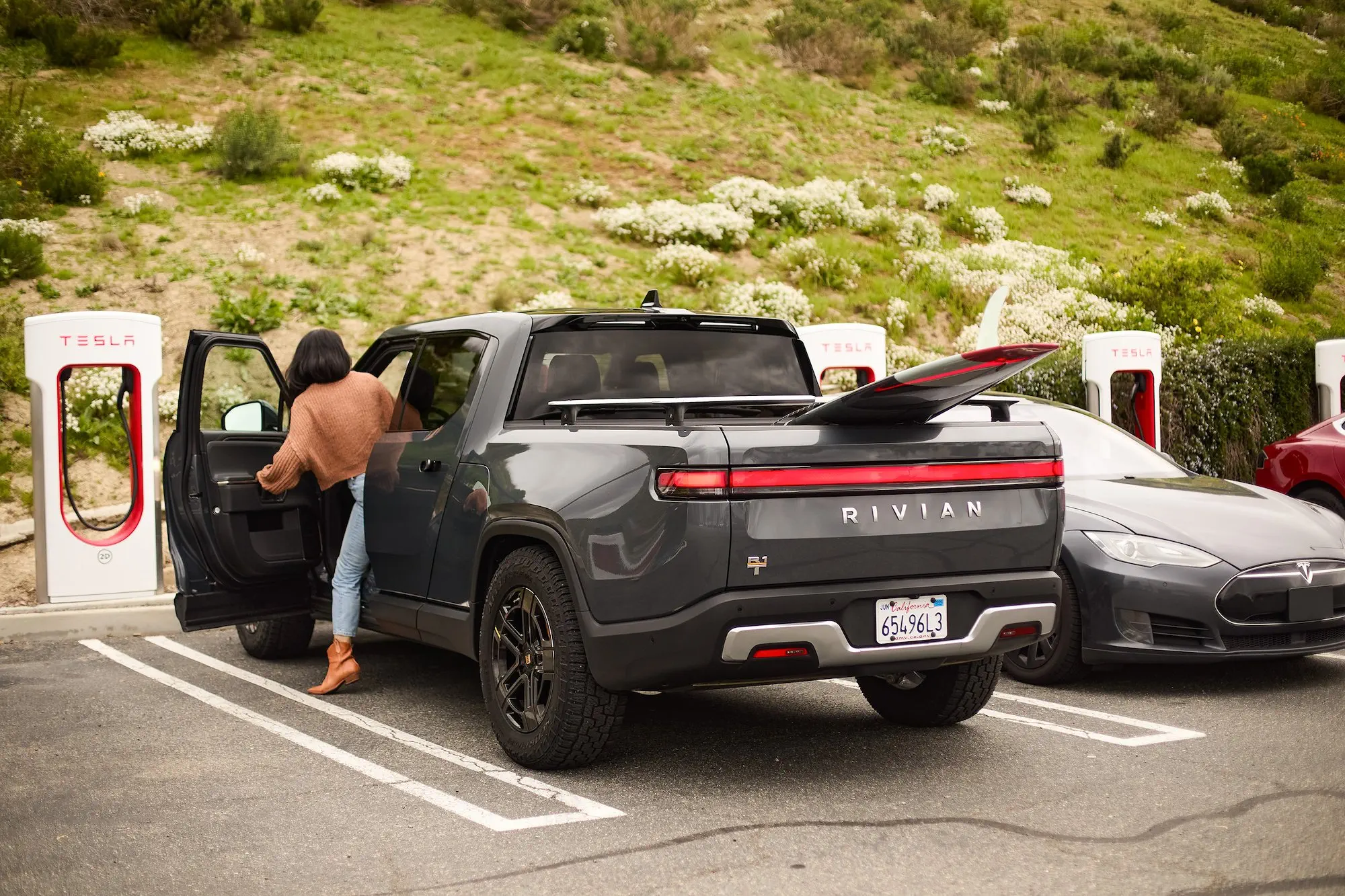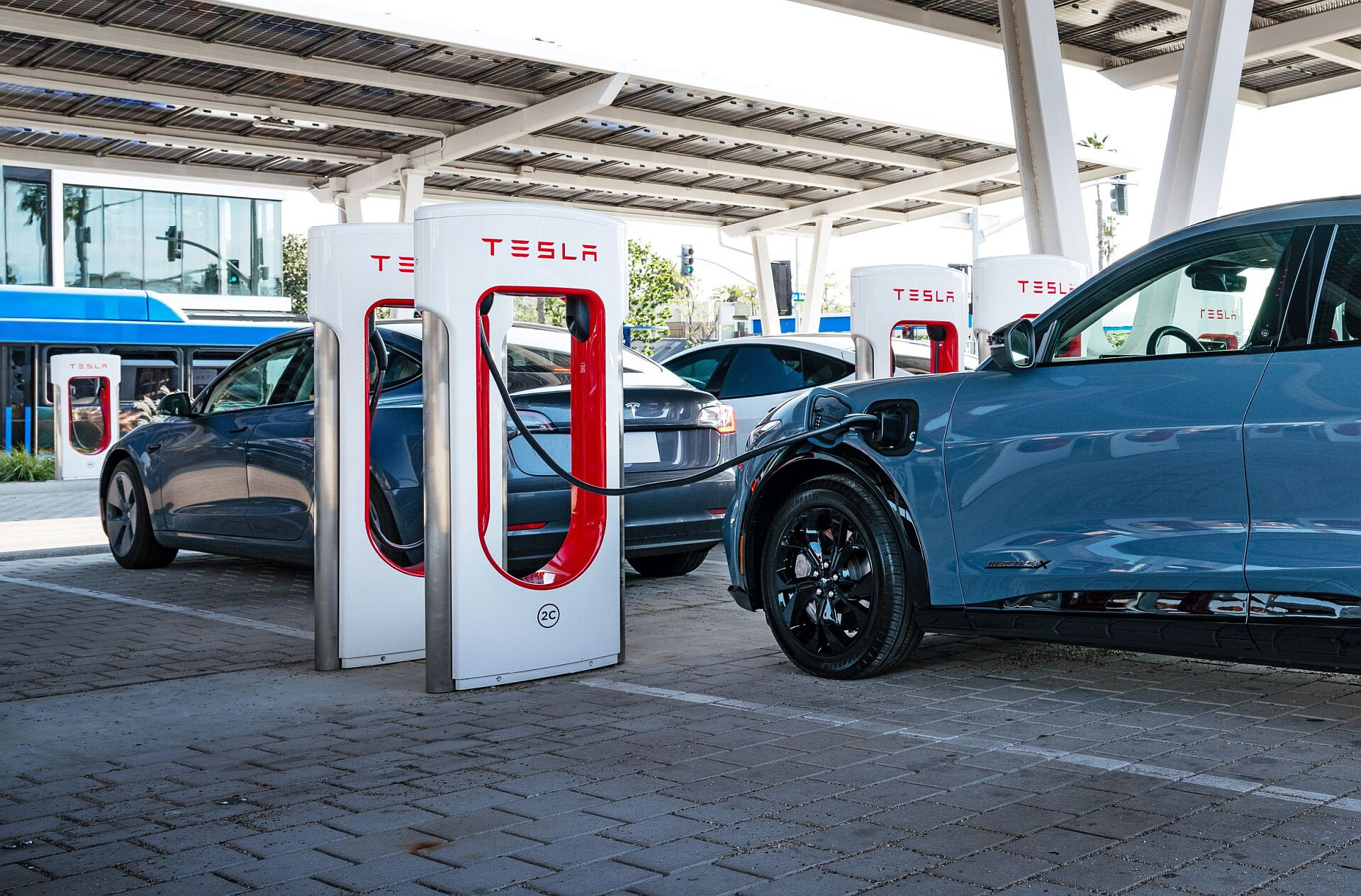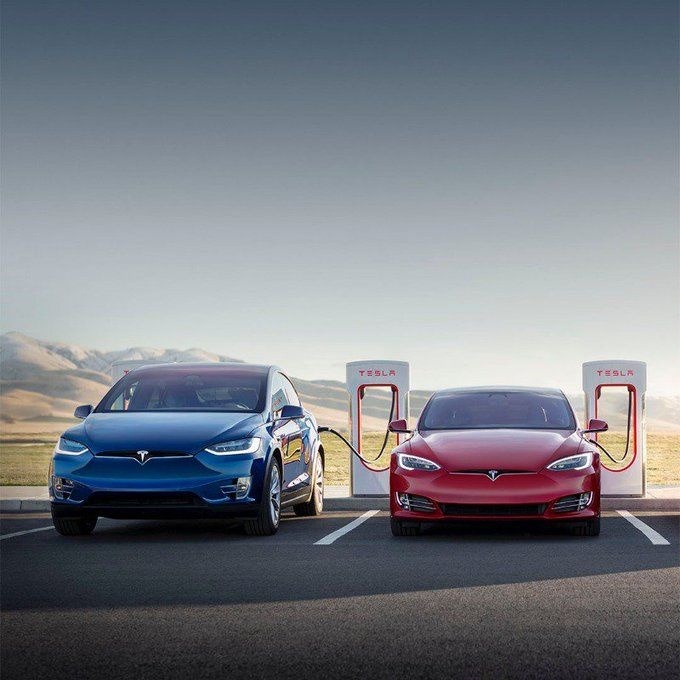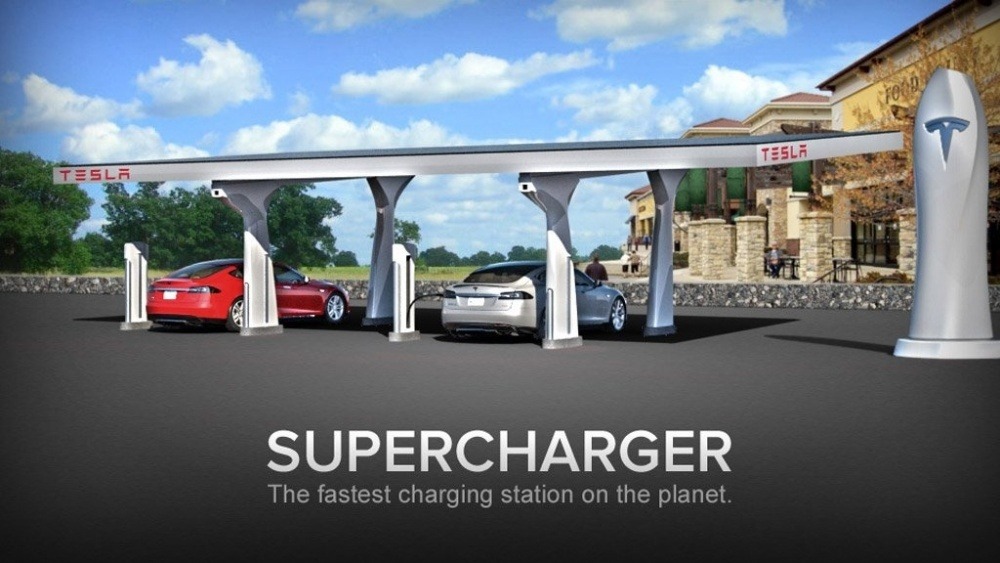Search the Community
Showing results for tags 'supercharging'.
-
Yesterday, Rivian announced that drivers of Rivian R1T and R1S vehicles are now able to charge at most Tesla Supercharger locations. Like Ford EV drivers, Rivian owners will receive a free NACS to CCS adapter. The Supercharger network has been integrated into Rivian's navigation and charging app, enabling "plug-and-charge" simplicity without needing to pull up an app. Billing for charge sessions at Tesla supercharger stations is handled automatically through the Rivian network. Starting in 2025 with the Rivian R1S and R1T, Rivian vehicles will adopt the NACS charge port, enabling drivers of those vehicles native access to the Supercharger network and other NACS chargers without an adapter. The Rivian R2 and Rivian R3 will be equipped with the NACS port from the start of production. Rivian announced in June, 2023 that they would adopt the NACS adapter and enable Tesla Supercharging access. They are the second automaker to do so, following Ford enabling Supercharger access earlier this month. Rivian has also been busy building its own Rivian Adventure Network, a series of charging stations focused on more remote locations where Rivian drivers might access like national parks. Currently, the Rivian Adventure Network is limited to Rivian drivers, but later this year Rivian will be opening access to all electric vehicles. The Rivian NACS to CCS adapters begin shipping in April. In the meantime, Rivian drivers might borrow a Ford NACS to CCS adapter from a friend. View full article
- 3 replies
-
- 1
-

-
- electric vehicle
- electric vehicle charging
-
(and 4 more)
Tagged with:
-
Yesterday, Rivian announced that drivers of Rivian R1T and R1S vehicles are now able to charge at most Tesla Supercharger locations. Like Ford EV drivers, Rivian owners will receive a free NACS to CCS adapter. The Supercharger network has been integrated into Rivian's navigation and charging app, enabling "plug-and-charge" simplicity without needing to pull up an app. Billing for charge sessions at Tesla supercharger stations is handled automatically through the Rivian network. Starting in 2025 with the Rivian R1S and R1T, Rivian vehicles will adopt the NACS charge port, enabling drivers of those vehicles native access to the Supercharger network and other NACS chargers without an adapter. The Rivian R2 and Rivian R3 will be equipped with the NACS port from the start of production. Rivian announced in June, 2023 that they would adopt the NACS adapter and enable Tesla Supercharging access. They are the second automaker to do so, following Ford enabling Supercharger access earlier this month. Rivian has also been busy building its own Rivian Adventure Network, a series of charging stations focused on more remote locations where Rivian drivers might access like national parks. Currently, the Rivian Adventure Network is limited to Rivian drivers, but later this year Rivian will be opening access to all electric vehicles. The Rivian NACS to CCS adapters begin shipping in April. In the meantime, Rivian drivers might borrow a Ford NACS to CCS adapter from a friend.
- 3 comments
-
- 1
-

-
- electric vehicle
- electric vehicle charging
-
(and 4 more)
Tagged with:
-
Owners of Ford Mustang Mach-E and F-150 Lightning vehicles have nearly doubled their charging location options overnight with 15,000+ new chargers added to the Ford BlueOval Charge Network. Last May, Ford announced they signed an agreement with Tesla for Ford EVs to gain access to Tesla Supercharger locations. Currently, the access is limited to just the two retail EVs that Ford sells and not the commercially oriented Ford e-Transit van. A Ford representative indicated that a future announcement for e-Transit drivers could be coming. In addition to access to the Tesla network, Ford will begin transitioning its EVs to use the new Tesla-designed NACS plug that is backward compatible with the existing Tesla design. Ford vehicles already built and sold with the CCS plug are eligible for a complimentary NACS to CCS adapter from Ford. Owners may register their VIN to receive their adapter in the Ford Pass app or at ford.com/FastChargingAdapter. Owners are allowed one free adapter per VIN. Charging a Mustang Mach-E or F-150 Lightning takes just two steps. Plug the adapter into the vehicle and plug the Supercharger cable into the plug in a simple Plug-to-Charge process. Drivers are charged for their session directly through the BlueOval network with whatever payment method is already set up. While 15,000+ Tesla Superchargers are available for Ford drivers' use, not every Tesla charger is compatible. Tesla Superchargers that have peak rates of 250+ kilowatts (kW) and an all-black charge cord and handle are compatible with Ford EVs. L2 Destination chargers and 150kW stations with a silver collar on the charge plug are not compatible. View full article
- 2 replies
-
- 1
-

-
- electric vehicle
- ev
-
(and 5 more)
Tagged with:
-
Owners of Ford Mustang Mach-E and F-150 Lightning vehicles have nearly doubled their charging location options overnight with 15,000+ new chargers added to the Ford BlueOval Charge Network. Last May, Ford announced they signed an agreement with Tesla for Ford EVs to gain access to Tesla Supercharger locations. Currently, the access is limited to just the two retail EVs that Ford sells and not the commercially oriented Ford e-Transit van. A Ford representative indicated that a future announcement for e-Transit drivers could be coming. In addition to access to the Tesla network, Ford will begin transitioning its EVs to use the new Tesla-designed NACS plug that is backward compatible with the existing Tesla design. Ford vehicles already built and sold with the CCS plug are eligible for a complimentary NACS to CCS adapter from Ford. Owners may register their VIN to receive their adapter in the Ford Pass app or at ford.com/FastChargingAdapter. Owners are allowed one free adapter per VIN. Charging a Mustang Mach-E or F-150 Lightning takes just two steps. Plug the adapter into the vehicle and plug the Supercharger cable into the plug in a simple Plug-to-Charge process. Drivers are charged for their session directly through the BlueOval network with whatever payment method is already set up. While 15,000+ Tesla Superchargers are available for Ford drivers' use, not every Tesla charger is compatible. Tesla Superchargers that have peak rates of 250+ kilowatts (kW) and an all-black charge cord and handle are compatible with Ford EVs. L2 Destination chargers and 150kW stations with a silver collar on the charge plug are not compatible.
- 2 comments
-
- electric vehicle
- ev
-
(and 5 more)
Tagged with:
-
After seeing its sales slide during the first quarter of this year, Tesla needed to come up with an incentive to help boost sales of the sagging Model-X and Model-S. In that effort, Tesla is returning the offer of free SuperCharging on all Model-S and Model-X sold. The plan was last offered in 2018 and then ended after Elon Musk called the plan unsustainable. Telsa has been making changes to their lineup and pricing almost monthly since the beginning of 2019, so this could be a short term offer or it could stick around longer. Tesla buyers who already purchased their car are out of luck though, the offer only extends to new purchases. View full article
-
After seeing its sales slide during the first quarter of this year, Tesla needed to come up with an incentive to help boost sales of the sagging Model-X and Model-S. In that effort, Tesla is returning the offer of free SuperCharging on all Model-S and Model-X sold. The plan was last offered in 2018 and then ended after Elon Musk called the plan unsustainable. Telsa has been making changes to their lineup and pricing almost monthly since the beginning of 2019, so this could be a short term offer or it could stick around longer. Tesla buyers who already purchased their car are out of luck though, the offer only extends to new purchases.
-
Tesla announced the evening of March 6th 2019 that Version 3.0 of their supercharging network would roll out across the globe and be in place by the end of calendar year 2019. With the growth of the global market and to support a ever growing base of Tesla 3 owners and the upcoming new products, charging needed to get faster to reduce wait times by their customers. As such. V3 Supercharging was born out of Tesla's experience with the world's largest grid connected batteries enabling Tesla to surpass all OEM auto competitors in recharging their electric auto's. V3 Supercharging is a utility scale new architecture product that can delivery a peak rate of 250kW per car using a new 1MW power cabinet delivered via liquid cooled charging lines. This allows the Tesla 3 to recover 75 miles of range in 5 min with a charge rate of 1000 miles per hour. This new charging technology cuts the average time spent recharging by 50%. In addition to the new 250kW Superchargers, Tesla is able to push out an update to the existing V2 Superchargers that will allow a 145kW charge rate on the 12,000 plus V2 Superchargers around the world. This will be coming in the next couple of weeks as Tesla works to reduce charge times at existing charge stations. Tesla is expecting to double by the end of the calendar year 2019 the number of Tesla auto's on the road globally and having a faster recharge time on existing Superchargers is critical, but in high volume areas, this will need to be addressed and Tesla says they can do this by adding the 250kW chargers to existing stations. Tesla V2 charging cable to the left, V3 liquid cable to the right. This new supercharger no longer splits power with the vehicle next to you but delivers the full amount of charge to your battery. Tesla expects the average time spent by a customer at a Supercharging station to drop to 15 min on average. Tesla is also pushing out to Tesla 3's a new On-Route battery Warmup software feature that will intelligently heat the battery to the optimal temperature so that at the time of arrival at the supercharging station it can take a full high capacity charge quickly to get you on your way. This becomes very important as Tesla says with the Model Y on the way V3 SuperCharging is the only way Tesla can sustain quickly keeping people moving and not waiting around. San Francisco bay area will get the first of the all new V3 Supercharger stations. These new V3 chargers will be made available to the Tesla Early Access Program participants. V3 Supercharging stations will get installed in North America during Q2 & Q3 time frames with Asia and Europe installations starting in Q4 of 2019. Now you might ask what about the Tesla S and X auto's? While they currently will not be able to take advantage of the 250 kW chargers, Tesla does say in their release that in the coming months, Tesla S and X will get software updates to allow them to use the 145kW V2 Superchargers. One might ask how does this compare to what the VW-backed Electrify America network? Electrify America is currently rolling out 350 kW capable chargers. These chargers will allow a Tesla 3 to get 185 miles of range in 9 minutes once the Tesla 3 has their new Software update. The Future of ultra fast recharging is coming and should allow a revolutionary change in the way people drive. View full article
- 16 replies
-
- 250kw charging
- electrify america
- (and 4 more)
-
Tesla announced the evening of March 6th 2019 that Version 3.0 of their supercharging network would roll out across the globe and be in place by the end of calendar year 2019. With the growth of the global market and to support a ever growing base of Tesla 3 owners and the upcoming new products, charging needed to get faster to reduce wait times by their customers. As such. V3 Supercharging was born out of Tesla's experience with the world's largest grid connected batteries enabling Tesla to surpass all OEM auto competitors in recharging their electric auto's. V3 Supercharging is a utility scale new architecture product that can delivery a peak rate of 250kW per car using a new 1MW power cabinet delivered via liquid cooled charging lines. This allows the Tesla 3 to recover 75 miles of range in 5 min with a charge rate of 1000 miles per hour. This new charging technology cuts the average time spent recharging by 50%. In addition to the new 250kW Superchargers, Tesla is able to push out an update to the existing V2 Superchargers that will allow a 145kW charge rate on the 12,000 plus V2 Superchargers around the world. This will be coming in the next couple of weeks as Tesla works to reduce charge times at existing charge stations. Tesla is expecting to double by the end of the calendar year 2019 the number of Tesla auto's on the road globally and having a faster recharge time on existing Superchargers is critical, but in high volume areas, this will need to be addressed and Tesla says they can do this by adding the 250kW chargers to existing stations. Tesla V2 charging cable to the left, V3 liquid cable to the right. This new supercharger no longer splits power with the vehicle next to you but delivers the full amount of charge to your battery. Tesla expects the average time spent by a customer at a Supercharging station to drop to 15 min on average. Tesla is also pushing out to Tesla 3's a new On-Route battery Warmup software feature that will intelligently heat the battery to the optimal temperature so that at the time of arrival at the supercharging station it can take a full high capacity charge quickly to get you on your way. This becomes very important as Tesla says with the Model Y on the way V3 SuperCharging is the only way Tesla can sustain quickly keeping people moving and not waiting around. San Francisco bay area will get the first of the all new V3 Supercharger stations. These new V3 chargers will be made available to the Tesla Early Access Program participants. V3 Supercharging stations will get installed in North America during Q2 & Q3 time frames with Asia and Europe installations starting in Q4 of 2019. Now you might ask what about the Tesla S and X auto's? While they currently will not be able to take advantage of the 250 kW chargers, Tesla does say in their release that in the coming months, Tesla S and X will get software updates to allow them to use the 145kW V2 Superchargers. One might ask how does this compare to what the VW-backed Electrify America network? Electrify America is currently rolling out 350 kW capable chargers. These chargers will allow a Tesla 3 to get 185 miles of range in 9 minutes once the Tesla 3 has their new Software update. The Future of ultra fast recharging is coming and should allow a revolutionary change in the way people drive.
- 16 comments
-
- 250kw charging
- electrify america
- (and 4 more)
-
G. David Felt Staff Writer Alternative Energy - www.CheersandGears.com Tesla Ends Free Charging Jan 1st 2017 Tesla has announced the end of their free supercharging for all new auto's starting January 1st 2017. CNBC has reported that Tesla has informed them that all auto's sold starting Jan 1st 2017 will only come with a free yearly use of 400KWh or equal to about 1000 miles of driving. After this users of their Supercharging stations will have to pay local electrical rate fee's up to a certain point. This is to allow Tesla to grow their north american network from the current 734 stations with 4600 superchargers. Their superchargers charge a 170 mile range in 30 min. Tesla also has stated that the cost to charge can and will fluctuate over time depending on the time of year and regional area due to the costs of electricity in that area. With Tesla planning to product annually 500,000 cars a year starting in 2018, many think this is necessary to grow. Others feel differently and further yet some wonder if they sell their existing Tesla S, does the life time of free charging transfer with the car to the new owner? This in itself could enhance resale of older tesla's built before January 1st 2017. Tesla has stated that more defined details will be released by the end of 2016. At this time, if you want lifetime free charging, buy your Tesla S or X now and take delivery by April 17th 2017. CNBC story
-
- ev charging
- free charging
-
(and 3 more)
Tagged with:
-
G. David Felt Staff Writer Alternative Energy - www.CheersandGears.com Turbocharging, Stop Gap Step to Variable Supercharging? I have come across multiple stories lately about Variable Supercharging. Torotrak has the rather dry scripted but exciting video about Variable Supercharging that delivers big engine feel all the time with none of the traditional Turbo lag or the high pressure, premium fuel requirement of traditional Superchargers. The video does cover how this variable Supercharging compares to turbo's and regular Superchargers. With the push for fuel economy and downsizing of engines by taxation on the size of an engine, we have all seen our auto companies move towards turbocharging small 3 & 4 cylinder engines to get higher MPG while trying to deliver big V8 block performance. Many have achieved some incredible performance out of smaller size engines, but with variable results in regards to reducing Turbo lag or affecting engine life. We have also seen where performance on either Turbos or Superchargers usually delivers peak efficiency at only certain rpm ranges that have resulted in exciting low-end response but no top end sustainability or top end fun with dull low end response. So this leads us to what has happened over the last 10 years or so. Seems to have started around 2006 at the Global Powertrain Congress with the fist 2 speed Supercharger by Antonov. I found we did have this posted in our S.E.M.A. section from 2006: https://www.cheersandgears.com/topic/12871-sema-preview-antonov-2-speed-supercharger/ Antonov 2 speed Supercharger - Company Closed in 2011 Lately over this last 10 years we now have the following 3rd party Variable Supercharger systems as follows: Eaton Variable Electric Roots Supercharger - available to work on traditional engines or hybrids. Fallbrook Tech. Variable planetary Supercharger ProCharger i-1 CVT Variable Supercharger - Discontinued product Final option is the Torotrak V-charger (Variable Supercharger) Interesting is that while the first 4 vendors have approached this from an add on application to auto driving fun. Torotrak according to their web site is going after the OEM channel by allowing their variable supercharger to be controlled by the OEM ECU. Their web site says 0 to 95% of target torque in 400 milliseconds and when not required, removal of boost just as fast. As you can see in the last picture above, you have the drive unit that has a ratio from .35:1 to 2.82:1 with output from 1050 to 8460 rpm. The fixed 12.67:1 planetary traction drive pushing out the supercharger centrifugal compressor running from 13,300 to 107,200 rpm. All in all some very cool technology with some being outdated already and others being delivered before it's time and dying. Yet we still have 3 of the 5 Superchargers on the market selling. What are your thoughts about this technology? Is this better than Turbochargers? Wonder why OEMs have embraced Turbochargers at a time that there does seem to be better options? Sound off on what your thoughts are about this technology! Web Sites used in compiling this story: http://www.greencarcongress.com/2008/05/antonov-pursuin.html https://www.companiesintheuk.co.uk/ltd/antonov-automotive-technologies http://www.eaton.com/Eaton/ProductsServices/Vehicle/Superchargers/index.htm http://www.fallbrooktech.com/accessory-drives/supercharger https://www.procharger.com/ http://www.torotrak.com/products-partners/products/v-charge/















